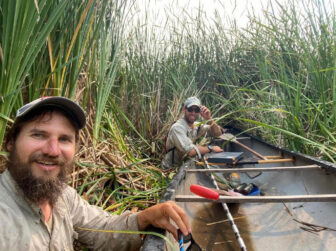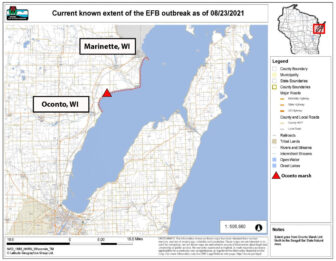
Jeremy Hartsock and Ryne Rutherford wading through a Wisconsin coastal wetland. Image: Jeremy Hartsock
By Caroline Miller
High water and ice scouring has shifted native wetlands inland and opened a door to invasive species along Wisconsin’s Lake Michigan coast.
A new study documents the first sighting of the invasive species, European frogbit, in Wisconsin and says that it could threaten native plants, fish and invertebrates.
The small, green, heart-shaped lily pad, forms dense mats along the surface of the water, blocking out sunlight that submergent plants need to survive, said Ryne Rutherford, a doctoral candidate for the Michigan Technological University School of Forest Resources and Environmental Science and the corresponding author to the study.
European frogbit is tough to control due its abundant reproduction, Rutherford said.
“No part of it actually has a root in the soil, they’re entirely floating,” Rutherford said. “They reproduce by these little structures called turion. So just think of them as little balls of vegetation that will produce at the end of the year, and they can produce hundreds of them.”
These dense mats create a zone underneath them where nothing can grow, he said.
Rutherford’s team surveyed the coastal wetlands of Oconto County, Wisconsin, and found that Lake Michigan rose two meters – about six and a half feet – in five years. The rise caused wetlands in an Oconto marsh to shift inland and some plants to die out, the study reported.

Oconto, Wisconsin, the research site where European frogbit was first documented in that state. Image: Jeremy Hartsock
From 2011 to 2021, satellite imagery showed a 50% decrease of wetlands due to deeper water drowning out emergent and wet meadow plants, such as ferns, reed and grass, the study reported.
Other causes of this wetland shift are wave action, ice scour and shoreline destabilization from an herbicide application to remove phragmites, a common wetland grass, Rutherford said.
“It was a lot for the plant communities to handle,” he said. “A lot of plants die off and a lot of wetland is completely lost.”
The team sampled three zones – submergent, emergent and wet meadow – where they saw big wetland shifts due to the rising water, Rutherford said.
“Particularly in that wet meadow zone, a lot of those plants aren’t that well adapted at dealing with the really high water so, a lot of those plant species have just disappeared,” Rutherford said.
The study found that many of the 101 plant species in Oconto County shifted inland to maintain a preferred water depth in response to the rising water.
“Great Lakes wetlands, they’re dynamic, and they had the ability to move these plants,” said Jeremy Hartsock, assistant researcher at the University of Wisconsin-Superior. “So, as the water went up, plants kept moving farther landward to maintain that preferential water level that they like to grow in.”
The higher water levels could be one reason European frogbit has ventured into the Oconto marsh, Hartsock said.
“Also, the presence of invasive species like cattails have shown to facilitate the establishment of frogbit,” Hartsock said. “What it does is it slows the wave action, which makes the water more still and that allows frogbit to establish.”
The invasion of European frogbit lowers the overall biodiversity of the marsh, Hartsock said.
“They can make them unsuitable for bird species that rely on certain plant structural attributes that they may nest in,” he said. “If an invasive comes in and removes that type of vegetation structure, those birds may not choose to nest there.”
Next steps for the team are to eradicate European frogbit and to look at lower water levels in certain areas and see how plant communities react in those systems, Rutherford said.